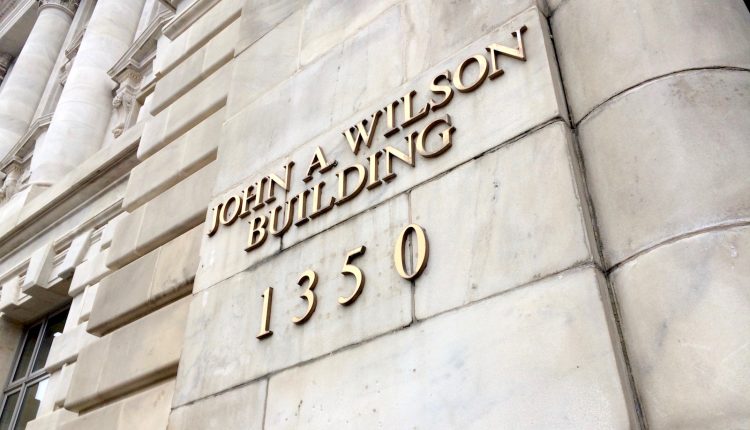Yesim Sayin Taylor: DC’s budget is growing at a faster pace than economic fundamentals can support
Relying on short-term revenue fixes to pay for spending increases doesn’t bode well for fair and competitive tax policy. Yet this is one of several troubling aspects of Mayor Muriel Bowser’s budget proposals now under review by the DC Council. The expenditure projections tell us a lot about the future shape of the District’s fiscal policy — and seem to signal that tax increases could be in the offing in future years.

On March 19, the mayor introduced her fiscal year 2020 budget, along with a four-year financial plan that goes through FY 2023 (which can be found in Chapter 2 of the Executive Summary). Much of the discussion since then has focused on the expenditure side — what was funded and what was shortchanged. The revenue side of the 2020 budget has received some attention, too (see here and here), but the changes to the revenue structure and longer-term expectations baked into the four-year financial plan also require careful examination.
‘DC Budgeting 101’: an overview of how the numbers add up
First, it’s helpful to understand some basics on budget terminology: The District’s own revenues (primarily taxes from incomes, businesses and property transactions, along with fines and fees) pay for the general expenditures that make up the local funds — the foundation of the District’s budget. In the FY 2019 budget, for example, the local funds equal $7.83 billion; in fiscal year 2020, the proposed figure is $8.58 billion.
Add on other locally generated revenues dedicated to a cause ($566 million in FY 2019) and special purpose revenues that compensate the government for providing a service ($704 million) and you get the general fund. An example of these dedicated revenues is the portion of the deed taxes set aside for housing; an example of special purpose revenue is the money the Department of Motor Vehicles collects from fees for issuing driver licenses.
Add to this mix the federal funds ($3.5 billion from matching grants like Medicare or grants like Scholarships for Opportunity and Results) and a small amount of money the District receives from private sources ($4 million in FY 2019), and you get the operating budget.
Next, add on enterprise funds ($1.9 billion) such as the budgets of related entities (for example, DC Water) to get the District’s gross funds.
The general fund is the most relevant — at least in the policy sense — to the District’s fiscal picture because that is where the DC government has the most control over its spending decisions. To expand on an existing program or add on something new within the executive’s purview, the mayor would use the general fund revenue. And cuts to any such government programs will return money back to the District’s general fund coffers for some other use.
Unlike adjustments to the local fund, changes to the dedicated taxes or special purpose revenue require the District to change its laws. For example, in the FY 2020 budget, the mayor is proposing to undedicate 5 percent of the sales tax to arts, reversing the council’s vote from last year to establish the dedicated tax. And sometimes, accounting changes from year to year move money from local fund to general fund and back. These are all reasons that focusing on the general fund as the policy base of the budget is appropriate.
In contrast, the District has little control over federal funds and must accept them as they come. Similarly, changing the amount of enterprise funds (such as the budget of DC Water) is nearly impossible.
Growth in DC’s baseline revenue is not enough to pay for the spending increase in this year’s proposed budget.
The mayor’s proposed FY 2020 budget is built on an 8.2 percent increase in general funds.
Compare this jump to the growth in economic fundamentals that essentially shapes the District’s tax base. According to the U.S. Bureau of Economic Analysis, personal incomes — the most important ingredient in revenue growth — rose at an annualized rate of 3.6 percent in the fourth quarter of 2018. Wage and salary earnings grew by just 2.2 percent. The DC Office of Tax and Revenue tells us that commercial property assessments grew by 2.42 percent, and residential property by 4.23 percent. Accordingly, the projected local fund revenues grew by 4 percent for FY 2020. This is less than half the growth in general fund expenditures.
The proposed budget fills the gap in FY 2020 with new taxes and savings from previous years. The mayor started with a total local revenue of $8.1 billion (per the CFO’s February revenue estimates), and her proposed budget adds on $127.9 million of new revenue proposals, $339.9 million of fund balance use, and $24.3 million of other resources. The use of the fund balance is especially notable, because this revenue is available only once; unlike annual tax revenue, once DC dips into its savings, those funds are gone.
The District is betting on having no growth in its FY 2021 budget.
As required by law, the mayor’s budget includes projections for revenues and expenditures for the next four years. As is also required by law, these projections all balance in the proposed budget and financial plan over that period. However, the budget documents predict that total expenditures will increase by only $61,500 — that is practically flat — between FY 2020 and FY 2021, and that operating expenditures will actually go down by about $70,000. This is because the one-time money that balances FY 2020 budget ($391 million in fund balance use) largely disappears in FY 2021, forcing the expenditure side to stay in line.
To be fair, the projected fund balance use for FY 2021 is lower in this proposed budget than it was in last year’s budget. Last year’s budget expected that in FY 2021, the District would be using $67 million from its previous savings to balance its budget. In that sense, the mayor’s FY 2020-2023 financial plan is structurally more sound than what she proposed (and the council approved) a year ago. But the spending is higher, too — $9.53 billion projected for FY 2021 in the FY 2019 budget cycle versus $9.81 billion in this year’s budget cycle.
This forecasted budgeting is a concern. Budget hawks would point out that some of the proposed spending in the FY 2020 budget is one-time ($183 million, to be precise) and could be clawed back without corresponding changes to DC law. While this observation is true, it is also a bit fatalistic. History shows that the District’s budget has rarely gone down outside of a recession year; once spending expectations are set, it is hard to reverse them.
If spending grows as it has historically, there will be tax increases in our future.
In his statement on the budget, Chairman Phil Mendelson criticized the mayor for proposing tax increases when tax revenues are already rising. But what the financial plan tells us is that next year, there will be even more pressure to raise taxes if spending grows at historical rates. And if the District does not take a step back and look at this issue outside the high-pressure environment of the budget season, its tax policy will become increasingly arbitrary and ad hoc.
To wit, the mayor’s proposed tax increases are somewhat opportunistic, with little relevance to the problems the budget is trying to solve, or any obvious consideration paid to sound tax principles.
First, the mayor undid the commercial property tax reduction the council approved in December. This was politically astute — the vote that approved the tax cut in December was very close, and would likely have been undone during the council budget discussions anyway. Seeing this, the mayor took it away. But this leaves us with a rather arbitrary commercial property tax structure that taxes the same value at different rates depending on the location of the property, or the size of the building on it.
Importantly, the mayor raised the deed transfer and recordation taxes from 2.9 percent to 5 percent for commercial transactions over $2 million. DC’s deed taxes had not been increased since 2007, making them a good candidate for a hike. Mayor Bowser has characterized the increase as “asking our commercial property owners to share the upside so that we can invest more in keeping D.C. affordable for Washingtonians across the income spectrum.” That is all fine. But the deed tax increase generates $90 million, and of this amount only $13 million is dedicated to housing. The rest goes to pay for other stuff.
The mayor’s observation regarding the “upside” is incomplete. Much of the value of public investments — good schools, strong transportation networks, low crime — capitalizes in the value of real property. Therefore, it makes sense to have a tax regime that generates revenue from where public investments have created the most value — that is, the upside. It turns out, however, that much of this upside is capitalizing in existing homes, and not new construction or even new commercial real estate. Yet it’s not politically palatable to raise the property tax rate for homeowners.
Under pressure, decisions like the ones in the proposed FY 2020 budget reduce the District’s tax policy to an exercise in getting to a number to plug into the budget. Seeking piecemeal revenue solutions reverses the District’s previous work to keep its tax regime simple and does little to maintain a fair and competitive tax system.
This is the worst news coming out of this budget.
Yesim Sayin Taylor is executive director of the D.C. Policy Center.
About commentaries
The DC Line welcomes commentaries representing various viewpoints on local issues of concern, but the opinions expressed do not represent those of The DC Line. Submissions of up to 850 words may be sent to editor Chris Kain at chriskain@thedcline.org.



Comments are closed.